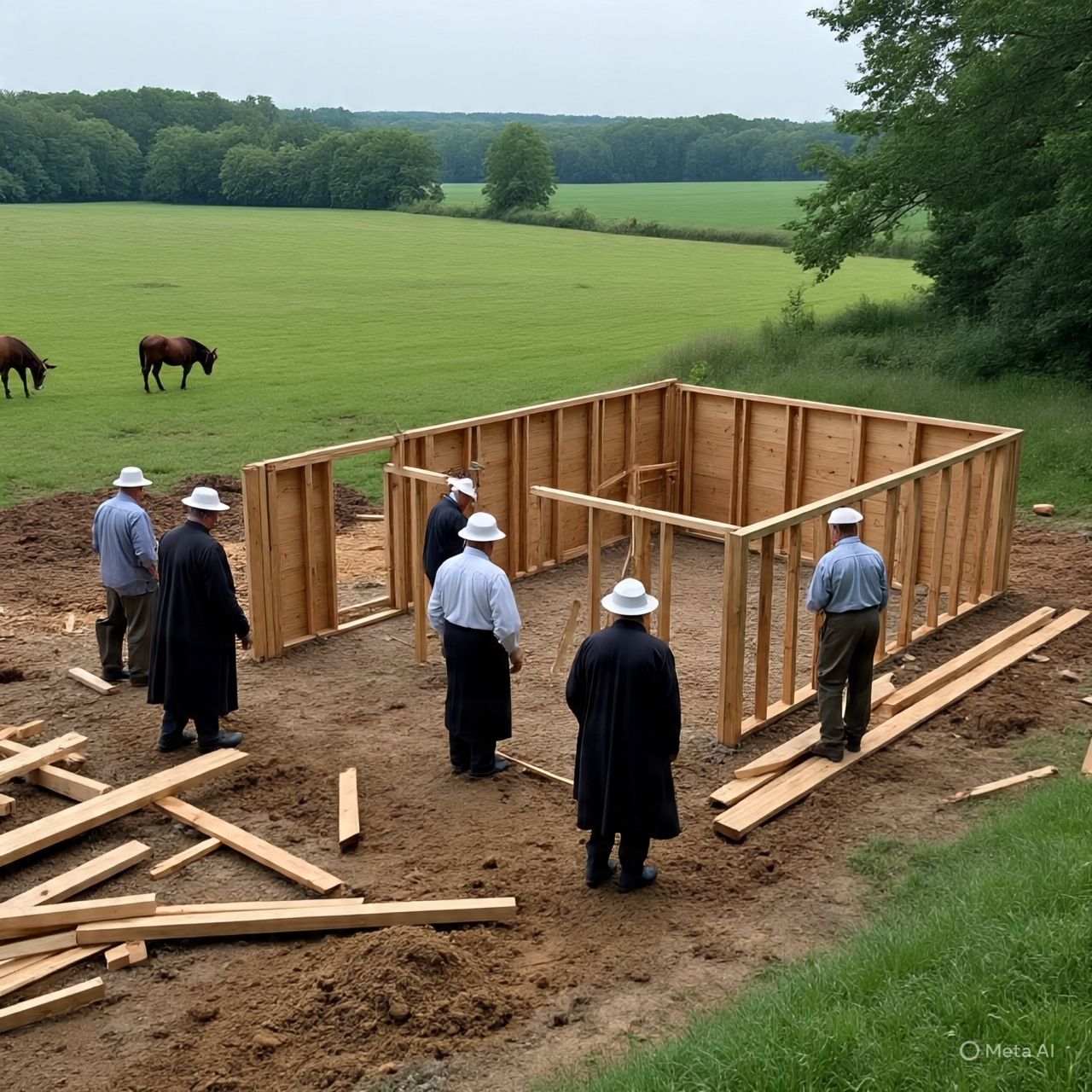FnF News
“The Amish Are Real, and They’re Building: Storm Survivors Say D.C. Could Learn a Thing or Two”
By Khadija Khan
June 3, 2025
Wilkes County, North Carolina — It’s early morning in the foothills of western North Carolina. The skies are clear for the first time in two weeks after a string of brutal supercell storms tore through the region, leveling homes, displacing families, and collapsing entire rural communities. Amid the rubble, one sound rises above the silence: the steady, rhythmic tap-tap-tap of hammers on wood. Not from contractors, not from FEMA, not from military aid crews.
From the Amish.
They came quietly. They came early. And they came with hand tools.
“They just showed up and started building,” said Maggie Lane, whose home was reduced to splinters in last week’s EF-3 tornado. “No permits, no contracts, no speeches. Just action.”
And yet, in some corners of the internet and the mainstream political conversation, their very existence has been mocked — even denied.
“They Don’t Exist”? Try Saying That to the Guy Raising a Barn Without Power Tools
It began as an offhand, condescending comment on a D.C. policy podcast two weeks ago. A progressive host scoffed, “The Amish? Do they even still exist?” The remark went viral — mostly for how spectacularly out of touch it was.
“Come down to Wilkes County,” said Sheriff Hank Mosley, chuckling. “We got more Amish nails in our houses than FEMA emails in our inboxes.”
The online backlash was swift. Photos and videos began circulating of bearded men in suspenders, sleeves rolled up, raising homes from bare soil. No generators. No bulldozers. No hashtags. Just people helping people.
And in that viral moment, the Amish became something far greater than just a footnote in rural American life.
They became a rebuttal — to bureaucracy, to cynicism, to inaction.
Amish Relief Crews Outbuild the State
According to local officials in the four hardest-hit counties — Wilkes, Caldwell, Alexander, and Surry — the Amish have rebuilt or are currently reconstructing over 40 homes, most of which were uninsured, underinsured, or simply too remote to be prioritized by official disaster relief channels.
“They’re not getting paid. They’re not taking selfies. They’re not waiting for cameras,” said Mayor Janice Holder of Taylorsville. “They saw a need and they showed up. What does that tell you?”
Holder, a centrist independent with years of experience in emergency management, said FEMA and state aid arrived late — and left early. But the Amish? Still here.
“They don’t ask who you voted for,” she added. “They ask where your well line is.”
When Humility Meets Hurricane Damage
Dressed in dark trousers, straw hats, and plain blue shirts, the Amish builders move in near silence. Their transportation? Horse-drawn wagons. Their materials? Donated lumber and salvaged boards. Their coordination? Word of mouth. No command center, no livestream, no press conferences.
“You’ll never see one of them stop to update an Instagram story,” joked local volunteer Reed Johnston. “But you’ll see a whole roof go up in a day.”
This community ethic — quiet, disciplined, resilient — has sparked a kind of cultural reckoning.
“We’re sitting here tweeting about climate change and these guys are putting up walls in 95-degree heat without power tools,” said national columnist Rachel Chen, who visited Wilkes County last weekend. “I don’t care if you’re left, right, or off the grid — that’s what America’s supposed to look like.”
Meanwhile, In Washington…
In stark contrast to the plain-dressed carpenters of North Carolina, Congress remains locked in a dead-spiral debate over budget ceilings and climate disaster preparedness funding. The Disaster Equity Act, still stalled in committee, has become a political football, with each party accusing the other of playing games with people’s lives.
“If the Amish had a lobbyist in D.C., we’d have homes by now,” said Sen. Mike Holloway (R-NC) during a fiery floor speech. “But they don’t want attention. They want results.”
Back home, that contrast isn’t theoretical — it’s tangible.
“You can feel the difference,” said school teacher Samantha Clark, who now teaches lessons in a tent pitched beside her wrecked mobile home. “One side’s talking. The other side’s building.”
Beyond Stereotypes: The Modern Amish Movement
What many outsiders fail to understand is that the Amish are not frozen in the 1800s. While they still reject electricity, motor vehicles, and most modern conveniences, many sects — including the New Order Amish and Beachy Amish Mennonites — actively participate in community outreach and disaster recovery across the country.
They’ve responded to floods in Kentucky, tornadoes in Illinois, and hurricanes in Texas.
“We do what we can,” said Eli Yoder, a soft-spoken team leader from Lancaster County, PA. “Our belief is that if someone’s barn falls, you help raise it again. Doesn’t matter who they are.”
He spoke while adjusting a level on a frame that would soon become a child’s bedroom.
“The world says everything’s complicated,” he added. “But sometimes, it’s not.”
Hand Tools, High Impact
The question many locals keep asking — sometimes in awe, sometimes in frustration — is: how is it possible that a group without internet, phones, or heavy machinery is outperforming multi-billion dollar federal agencies?
The answer might lie in one word: focus.
“There’s no paperwork delay. No permits. No waiting for an approval from Raleigh or D.C.,” said Jacob Boone, a former Marine turned volunteer. “They just get out of the buggy and get to work.”
While FEMA continues assessing “damage zones,” the Amish assess human need. It’s a different kind of math.
The Political Undercurrent: A Quiet Rebellion
To many Americans — especially in rural states — the Amish now symbolize something deeper than recovery. They represent a quiet defiance against the complexity, inefficiency, and moral detachment of federal systems.
“In a world where everyone’s talking about doing things,” said radio host Mitchell Crane, “they’re actually doing them. And it’s driving elites crazy.”
Online, the Amish resurgence has sparked memes, tribute videos, and even new political slogans. One trending phrase: “Amish Get It Done” — printed over black-and-white images of barn frames and muddy boots.
Some far-right circles have even begun elevating Amish efforts as proof that government isn’t necessary, though most Amish leaders strongly reject political co-option.
“We’re not here to make statements,” said David Troyer, a bishop from Ohio’s Holmes County. “We’re here to serve.”
Still, in a hyper-politicized moment, that statement — in and of itself — is a kind of revolution.
Final Word: Don’t Tell the Amish They’re Irrelevant — They Might Rebuild Your Town
The next time someone snidely suggests the Amish “don’t exist” or are merely a curiosity fit for tourist photos, send them to Brushy Fork Road, or Whippoorwill Hollow, or the edge of Lenoir where the tarps have been pulled back and roofs rise under the strength of men who say little and build much.
Because while America argues about who’s real, who’s fake, who matters, and who’s to blame — the Amish are handing a young boy a door to his new room. They’re setting cabinets. They’re raising beams. They’re driving pegs by hand.
“You can have your headlines,” said Margie Runnels, watching a second floor go up on her property. “We’ll take the people who show up.”

